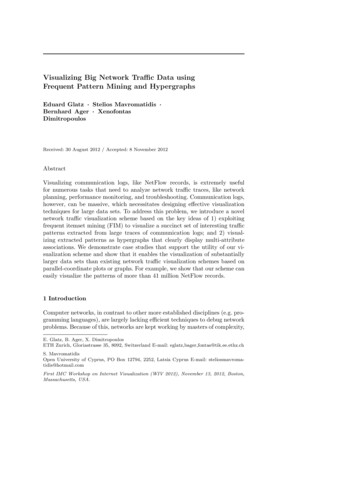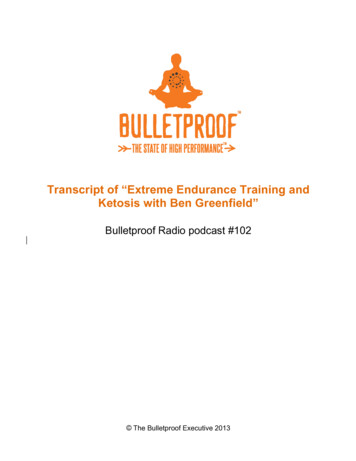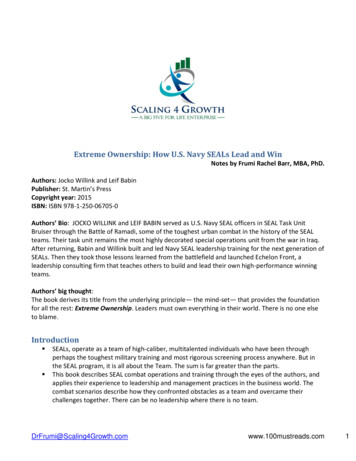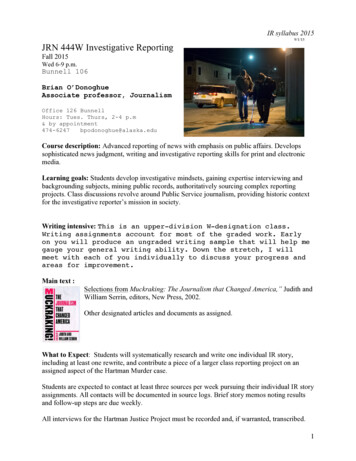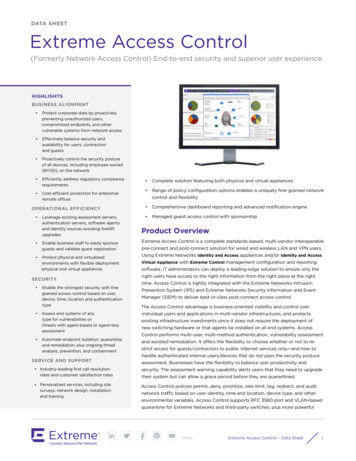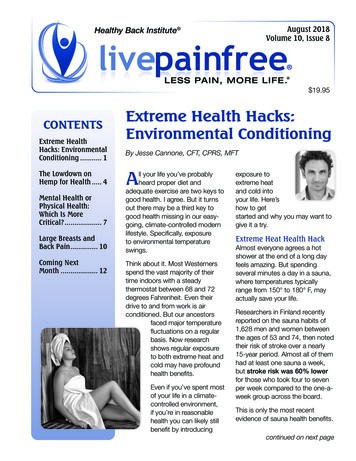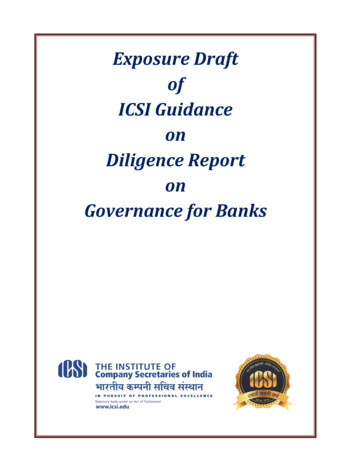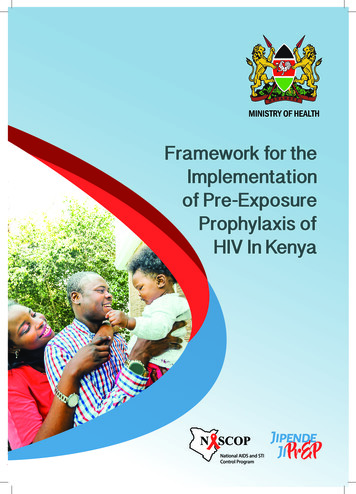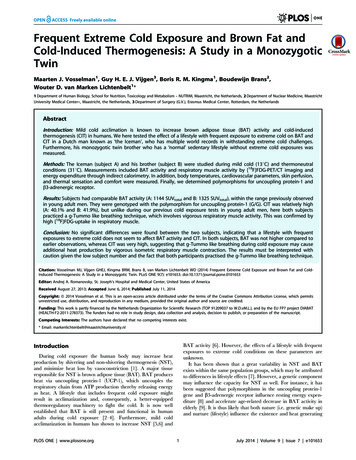
Transcription
Frequent Extreme Cold Exposure and Brown Fat andCold-Induced Thermogenesis: A Study in a MonozygoticTwinMaarten J. Vosselman1, Guy H. E. J. Vijgen3, Boris R. M. Kingma1, Boudewijn Brans2,Wouter D. van Marken Lichtenbelt1*1 Department of Human Biology, School for Nutrition, Toxicology and Metabolism – NUTRIM, Maastricht, the Netherlands, 2 Department of Nuclear Medicine, MaastrichtUniversity Medical Center , Maastricht, the Netherlands, 3 Department of Surgery (G.V.), Erasmus Medical Center, Rotterdam, the NetherlandsAbstractIntroduction: Mild cold acclimation is known to increase brown adipose tissue (BAT) activity and cold-inducedthermogenesis (CIT) in humans. We here tested the effect of a lifestyle with frequent exposure to extreme cold on BAT andCIT in a Dutch man known as ‘the Iceman’, who has multiple world records in withstanding extreme cold challenges.Furthermore, his monozygotic twin brother who has a ‘normal’ sedentary lifestyle without extreme cold exposures wasmeasured.Methods: The Iceman (subject A) and his brother (subject B) were studied during mild cold (13uC) and thermoneutralconditions (31uC). Measurements included BAT activity and respiratory muscle activity by [18F]FDG-PET/CT imaging andenergy expenditure through indirect calorimetry. In addition, body temperatures, cardiovascular parameters, skin perfusion,and thermal sensation and comfort were measured. Finally, we determined polymorphisms for uncoupling protein-1 andb3-adrenergic receptor.Results: Subjects had comparable BAT activity (A: 1144 SUVtotal and B: 1325 SUVtotal), within the range previously observedin young adult men. They were genotyped with the polymorphism for uncoupling protein-1 (G/G). CIT was relatively high(A: 40.1% and B: 41.9%), but unlike during our previous cold exposure tests in young adult men, here both subjectspracticed a g-Tummo like breathing technique, which involves vigorous respiratory muscle activity. This was confirmed byhigh [18F]FDG-uptake in respiratory muscle.Conclusion: No significant differences were found between the two subjects, indicating that a lifestyle with frequentexposures to extreme cold does not seem to affect BAT activity and CIT. In both subjects, BAT was not higher compared toearlier observations, whereas CIT was very high, suggesting that g-Tummo like breathing during cold exposure may causeadditional heat production by vigorous isometric respiratory muscle contraction. The results must be interpreted withcaution given the low subject number and the fact that both participants practised the g-Tummo like breathing technique.Citation: Vosselman MJ, Vijgen GHEJ, Kingma BRM, Brans B, van Marken Lichtenbelt WD (2014) Frequent Extreme Cold Exposure and Brown Fat and ColdInduced Thermogenesis: A Study in a Monozygotic Twin. PLoS ONE 9(7): e101653. doi:10.1371/journal.pone.0101653Editor: Andrej A. Romanovsky, St. Joseph’s Hospital and Medical Center, United States of AmericaReceived August 27, 2013; Accepted June 6, 2014; Published July 11, 2014Copyright: ß 2014 Vosselman et al. This is an open-access article distributed under the terms of the Creative Commons Attribution License, which permitsunrestricted use, distribution, and reproduction in any medium, provided the original author and source are credited.Funding: This work is partly financed by the Netherlands Organization for Scientific Research (TOP 91209037 to W.D.vM.L.), and by the EU FP7 project DIABAT(HEALTH-F2-2011-278373). The funders had no role in study design, data collection and analysis, decision to publish, or preparation of the manuscript.Competing Interests: The authors have declared that no competing interests exist.* Email: markenlichtenbelt@maastrichtuniversity.nlBAT activity [6]. However, the effects of a lifestyle with frequentexposures to extreme cold conditions on these parameters areunknown.It has been shown that a great variability in NST and BATexists within the same population groups, which may be attributedto differences in lifestyle effects [7]. However, a genetic componentmay influence the capacity for NST as well. For instance, it hasbeen suggested that polymorphisms in the uncoupling protein-1gene and b3-adrenergic receptor influence resting energy expenditure [8] and accelerate age-related decrease in BAT activity inelderly [9]. It is thus likely that both nature (i.e. genetic make up)and nurture (lifestyle) influence the existence and heat generatingIntroductionDuring cold exposure the human body may increase heatproduction by shivering and non-shivering thermogenesis (NST),and minimize heat loss by vasoconstriction [1]. A major tissueresponsible for NST is brown adipose tissue (BAT). BAT producesheat via uncoupling protein-1 (UCP-1), which uncouples therespiratory chain from ATP production thereby releasing energyas heat. A lifestyle that includes frequent cold exposure mightresult in acclimatization and, consequently, a better-equippedthermoregulatory machinery to fight the cold. It is now wellestablished that BAT is still present and functional in humanadults during cold exposure [2–4]. Furthermore, mild coldacclimatization in humans has shown to increase NST [5,6] andPLOS ONE www.plosone.org1July 2014 Volume 9 Issue 7 e101653
Brown Fat and Cold in a Monozygotic Twinmild cold exposure (12–13uC). The [18F]fluorodeoxyglucose(FDG) tracer was injected intravenously after 90 minutes in thecold and 60 minutes later the PET-CT scan was performed. Themeasurements were performed in a specially equipped airpermeable tent (Colorado altitude training, USA), in whichambient temperature was tightly controlled. Subjects weremeasured in semi-supine position on an air-permeable stretcher(Model Campart Rome-XL) in order to lie comfortably. Thesubjects wore shorts only (Clo 0.06)[13]. During the experimentswe measured energy expenditure via indirect calorimetry (Ventilated Hood, Omnical 2, Maastricht, the Netherlands), heart ratevia a monitor on the chest (Polar T31, USA), and blood pressurevia a pressure cuff on the left upper arm (Cresta, Taiwan). Meanarterial blood pressure (MAP) was calculated as MAP 1/3Systolic pressure 2/3 Diastolic pressure. Skin temperatures weredetermined via wireless temperature sensors placed at the 14 sitesprescribed by ISO-standard 9886:2004 (Ergonomics – Evaluationof thermal strain by physiological measurements, InternationalStandards Organization, Geneva, Switzerland) (iButtons Maximintegrated, USA), and core temperature via a telemetric pill(CorTemp HT150002, USA), which was ingested one hour beforethe onset of the experiment. Vasoconstriction was measured bydetermining the change in skin perfusion via Laser Doppler at theventral side of the hand at the base of the thumb, at the ventralside of the hallux (Perimed PF4000, Sweden), at the ventral side ofthe forearm halfway between the elbow and the wrist, and at theabdomen halfway between the umbilicus and the left lateral side ofthe body (Perimed PF5000, Sweden). Venous blood samples weretaken during baseline and in the cold for analysis of hormones andmetabolites, and DNA analysis via PCR to identify polymorphismsfor uncoupling protein-1 (-3286 A/G polymorphism) [14] and theb3-adrenergic receptor (Trp64Arg) [15].During the mild cold experiment, both subjects completedvisual analogue scales (VAS-scales) [16], on sensation, thermalcomfort and shivering. Furthermore, BAT activity was assessed by[18F]fluorodeoxyglucose-positron emission-tomography-computedtomography ([18F]FDG-PET-CT) (Gemini TF PET-CT, Philips,The Netherlands). The protocol and analysis were comparable toour previous studies using static imaging [17]. A low-dose CT scan(120 kV, 30 mAs) preceded the PET scan, and was used forattenuation and scatter correction of the PET scan. The PET scanwas used to determine [18F]FDG-uptake. Temperature wasregulated with a heater and air-conditioning. Body compositionwas determined by means of dual x-ray absorptiometry (DXA,Hologic, type Discovery A, USA), and in the afternoon, a biopsywas taken from the m. vastus lateralis for mitochondrialrespirometry measurements in permeabilized muscle fibers bymeans of the Oxygraph-2K (Oroboros, Austria). A part of thebiopsy was placed in a preservation medium for the respirationmeasurements (for substrate details see [6]), and a portion of themuscle tissue was immediately frozen in melting isopentane andstored at 280uC for determination of mitochondrial DNA(mtDNA) copy number (ratio ND1 to LPL).potential of BAT. Next to BAT, also other tissues, such as skeletalmuscle, might contribute to NST [10].In this perspective, we report on the thermoregulatory responsesof a monozygotic twin. One of the twins, the so-called ‘‘Iceman’’,has been exposed to frequent periods of extreme cold for severaldecades. He is world-record holder in withstanding extreme coldexposure under several disciplines, such as the fastest halfmarathon on snow and ice while barefoot, and the longestduration while fully immersed in crushed ice (1 hour and 50minutes). He claims to achieve these records through a specialmeditation and breathing technique, which is based on g-Tummomeditation, and that he is capable to regulate his own autonomicnervous system. A recent case study demonstrated that he wascapable to control the autonomic stress response during endotoxemia by using this technique [11]. His monozygotic twin brotherdoes not experience extreme cold exposure due to a differentoccupation and a sedentary lifestyle, although he is aware of thetechniques used by his brother. We here tested the hypothesis thatthe iceman has a higher cold-induced heat production and coldinduced BAT activity compared to his identical twin brother. Thiscase study provides a unique comparison between a monozygotictwin pair, one being extremely cold-acclimated the other being notcold-acclimated at all.MethodsSubjectsThe Medical Ethical Committee of the Maastricht UniversityMedical Centre approved the protocols and both the Iceman(subject A) and his twin brother (subject B) gave written informedconsent. All procedures were conducted according to theprinciples of the Declaration of Helsinki. The monozygotic twinbrothers are both male and 52 years of age. They were screenedfor medical history, and were absent of any factors related to themetabolic syndrome, and had no thyroid gland dysfunction. Theywere not using any type of medication, which could have affectedthe results. Subject A is well known for his capability to withstandextreme cold challenges. He is a self-employed lifestyle educator,focusing on the capacity of the human mind to control its body bymeans of a special meditation and breathing technique (based ong-Tummo) [12]. He has been exposing himself to daily cold waterswimming/showers and regularly visits Scandinavian and arcticregions in order to practice and train extreme cold exposure inshorts only. Subject B is employed as an international truck driver,being on the road for multiple days in a row and experiencinglonger periods of inactivity. He does not practice and trainextreme cold exposure. However, he is familiar with the specialmeditation and breathing technique used by his brother.Study design and measurementsSubjects were measured on two separate occasions during twoconsecutive days in the winter season with comparable outdoortemperatures. The study protocols in both subjects were identical.In the morning of day one, BAT activity was measured duringthermoneutral conditions (i.e. two hours at air temperature 31uC),which served as a control-measurement (Figure 1). In theafternoon of day one, a ‘‘shivering test’’ was performed with thepurpose to determine the air temperature associated with the onsetof shivering. This information was then used for the mild coldexperiment on day two to determine the ambient temperature toobtain maximal cold-induced thermogenesis (CIT) (i.e. at thelowest temperature without shivering). The mild cold experimenton day two started with a 45-minute baseline during thermoneutral conditions (,31uC), followed by two and half hours ofPLOS ONE www.plosone.orgData and PET-CT analysisAt fixed time intervals of 25 minutes duration during baselineand during cold exposure (after injection of [18F]FDG) energyexpenditure was calculated. We use the term CIT instead ofclassical NST for the increase in energy expenditure (as apercentage) during cold exposure, as respiratory muscle contraction was involved. These time periods were also selected foranalysis of cardiovascular and body temperature parameters. Tworesearchers (M.V. and G.V.) and a nuclear-medicine physician(B.B.) analyzed the PET-CT scan. In order to determine BAT2July 2014 Volume 9 Issue 7 e101653
Brown Fat and Cold in a Monozygotic TwinFigure 1. Study protocol. The thermoneutral experiment started in the morning on day one. After one hour a blood sample was taken andsubsequently the [18F]FDG tracer was injected followed by the PET-CT scan one hour later. In the afternoon of day one, the shivering experiment wasconducted, which started with a baseline period of 45 minutes during 31uC followed by 90 minutes of mild cold exposure (31uC) to determine theambient temperature at which shivering occurred. The mild cold experiment on day two consisted of 45 minutes baseline (31uC) followed by 150minutes of cold exposure. Blood samples were taken at the end of the baseline period and 90 and 150 minutes after the onset of cold exposure. The[18F]FDG tracer was injected 90 minutes after the onset of cold exposure, followed by the PET-CT scan one hour y, we measured the average [18F]FDG-uptake, known as themean standard uptake value (SUVmean), and the total [18F]FDGuptake (SUVtotal SUVmean multiplied by BAT volume) in BATby manually drawing regions of interest. We considered fat tissueas BAT when the Hounsfield Units of the CT-scan were between 10 and 180. Moreover, a minimum of 1.5 SUV was used to classifythe selected fat region as BAT. Furthermore, we analyzed average[18F]FDG-uptake (SUVmean) in multiple tissues in fixed volumes ofinterest according to the procedure described in Vosselman et al.2013 [18]. The blood parameters presented in the subjectcharacteristics were compared to normal reference valuespresented in the assay/kit information and with respect to thethyroid parameters, references values were obtained from thedepartment of clinical chemistry at Maastricht University MedicalCentre (Maastricht, the Netherlands). Since it was impossible tostudy the statistical difference between the two brothers, wecompared the current results with data from previous studies inyoung adult men. To do so, we made boxplots of the data fromyoung adult men and determined the interquartile range and the95th percentile. When the results of the twin were within theinterquartile range observed in young adult men, we regardedboth values (subject A and subject B) as comparable. When thescore of one of the twin brothers was outside the interquartilerange, this was regarded as different from each other. Furthermore, the score of the twins were considered as different fromyoung adults when the score was outside of the 95th percentile.This comparison has its limitations due to the differences in agebetween the young adult group and the twin brothers. Furthermore, it should be noted that the current cooling protocol lasted30 minutes longer (2,5 hours versus 2 hours), and clothing was less(clo 0.1 versus 0.49). Therefore, temperature, skin perfusion, andcardiovascular data of the twin could not be compared with theyoung adults. However, for these measurements intra subjectPLOS ONE www.plosone.orgcomparison was based on the measurement accuracy. BATactivity and CIT could be compared due to the use of the sameindividualized protocol in all subjects in which we cool the subjectsto temperatures just above shivering, in order to obtain maximalNST and BAT activity in each subject (for more details on thisprotocol see [17]). The respiration values for skeletal muscle arerepresented as the average of two traces with standard deviation.ResultsSubject characteristicsSubject A had a lower fat percentage (13.7% versus 18%;normal range 11–22%), comparable fat free mass (69.4 kg versus68.1 kg) and lower fasting triglyceride levels (subject A: 698 mmol/L versus subject B: 1060 mmol/L; normal range: 680–1880 mmol/L) than subject B (Table 1). Fasting glucose levels were equal(both 5.7 mmol/L; normal range: 3.61–6.11 mmol/L). Thyroidstimulating hormone levels were comparable, and within thenormal range (A: 1.1 mU/L versus B: 0.9 mU/L; normal range0.4–4.3 mU/L). Total T4 was slightly lower in subject A, and freeT4 levels were comparable (total T4: A: 84 nmol/L versus B:96 nmol/L; normal range: 60–150 nmol/L; free T4: A:14.8 pmol/L versus B 14.7 pmol/L; normal range: 8–18 pmol/L). Furthermore, subject A had a more active lifestyle, althoughboth were more active compared to the average found in youngadults, indicated by the Baecke Questionnaire scores (total score:A: 11.4 versus B: 9.7; average young adults: 68.2, derived from[19]). Interestingly, the monozygotic twin was genotyped with thepolymorphism for uncoupling protein-1 (G/G). These G-allelecarriers have been associated with an attenuation of UCP-1mediated thermogenesis [20]. No polymorphism (no Arg64 allele)was present in the b3-adrenergic receptor.3July 2014 Volume 9 Issue 7 e101653
Brown Fat and Cold in a Monozygotic TwinTable 1. Subject characteristics.Subject ASubject BHeight (cm)183184Weight (kg)82.287.0BMI (kg/m2)24.725.8Fat percentage (%)13.718Lean mass (kg)69.468.1Fasting glucose (mmol/L)5.75.7Fasting triglycerides (mmol/L)6981060Thyroid stimulating hormone (mU/L)1.10.914.7Total T4 (nmol/L)14.8Free T4 (pmol/L)8496Resting Metabolic Rate (MJ/day)8.17.8Baecke Questionnaire Score (WI/SI/LI (total)*3.1/4.3/4 (11.4)2.4/3.5/3.8 (9.7)*WI work index, SI sport index, LI leisure time index,doi:10.1371/journal.pone.0101653.t001771 mmol/L; B: baseline 264 mmol/L versus cold 705 mmol/L),whereas plasma glucose, insulin and epinephrine concentrationsslightly decreased (Table S1). Plasma norepinephrine increased inboth subjects, however, the concentration during cold was markedlyhigher in subject B (A: 554 ng/L versus B: 1016 ng/L), suggestinggreater sympathetic activity.Physiological parameters and thermal sensation duringcold exposureInterestingly, during the ‘‘shivering experiment’’ on day one,both subjects did not reach the point of shivering. Normally, insuch conditions with temperature drops from 31 to 13uC, youngadults and elderly start shivering [21,22]. The next day wemaximally decreased ambient temperature and temperaturesdropped to maximally 12uC. Again, no shivering was observedduring this cold experiment. Mean skin temperature wascomparable between the subjects during baseline (A: 33.22uCversus B: 33.40uC, Table 2), however during cold exposure meanskin temperature decreased more pronounced in subject Bcompared to subject A (A: 27.57uC versus B: 25.95uC). Thisdecrease was predominantly seen in the proximal region (A:29.36uC versus B: 27.81uC). Both subjects had comparablevasoconstriction in the hand (A: 91,7% versus B: 91,3%) and toe(A: 96% versus B: 96.4%), although subject A had a slightly lowerdistal temperature (A: 21.43uC versus B: 22.34uC). Subject Ashowed more vasoconstriction in the underarm (A: 63.3% versusB: 8.8%) and abdomen (A: 7% versus B: 28.8% (vasodilation)).Core temperature decreased in both subjects with a smallerdecrease (20.18uC) in subject A compared to subject B (20.40uC).As the accuracy of the measurement is 60.1uC and due to thesmall range within core temperature is held, we interpreted thedifference of 20.22uC as physiologically different. There was aclear difference in cold sensation and comfort between bothsubjects. Both subjects experienced the thermal environment asneutral during baseline, however subject A reported neutral toslightly
regulated with a heater and air-conditioning. Body composition was determined by means of dual x-ray absorptiometry (DXA, Hologic, type Discovery A, USA), and in the afternoon, a biopsy was taken from the m. vastus lateralis for mitochondrial respirometry measurements in permeabilized muscl
